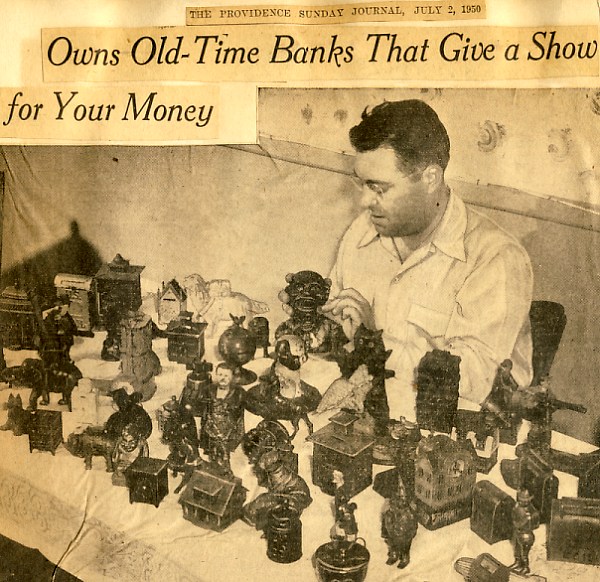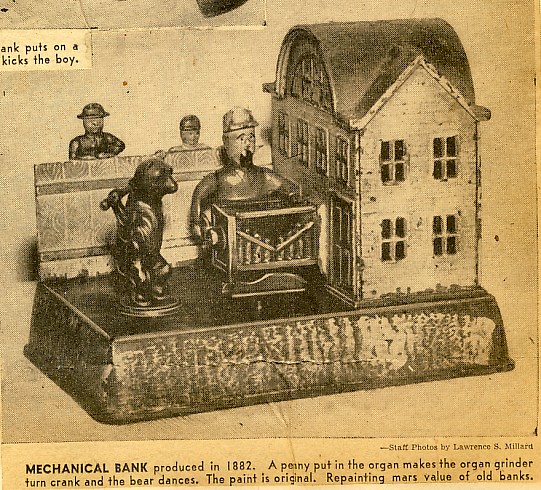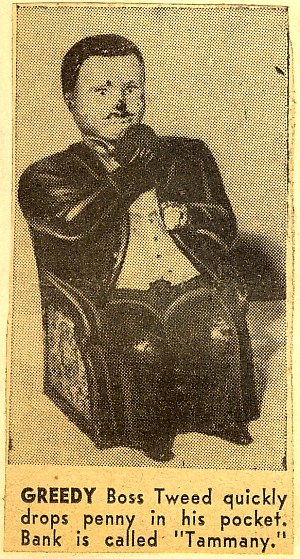|
THE PROVIDENCE SUNDAY JOURNAL, JULY 2, 1950
Old-Time Banks That Give a Show for Your Money
By Dorothy Agnew — Providence, Rhode Island Newspaper, o/a 1949
His Mechanical Savers Dance, Grin or Kick for a Penny

His Mechanical Savers Dance,
Grin or Kick for a Penny
By Dorothy Agnew
DURING the 1870’s and ‘80’s and 90’s and the first decade of
the 1900’s mechanical banks in great variety appeared on the market.
These cast-iron banks — each putting on its own special little act when a coin was
fed to it — were designed to encourage the youngsters of the day to salt away every
penny. They were also produced with an eye toward intriguing the parents and relatives of
children as well as friends who came to call into opening up their purses for a coin to
swell the savings.
But many a penny was put into these banks just to make them perform and immediately
removed by the way of the trap door at the back or the bottom.
Original Price Cheap
The rough handling the banks were subjected to probably accounts for their scarcity
today and the shabby appearance of most of those which have survived. Despite the fact
that they were produced in enormous quantities and sold at very low prices they are quite
rare now and they are being eagerly sought by collectors at prices often more than 50
times what they sold for originally.
After building up a worthwhile collection of stamps and more than 10,000 Rhode Island
view cards, Rudolf A Salvatore two years ago turned his attention to old banks. In his
home at 107 Chapin Avenue more than 75 of them are on display. Twelve are mechanical and
in excellent working condition.
The collection started with an ordinary cast-iron bank. It was devoid of any mechanism
other than a screw which locked the two halves together. The bank, shaped like the
Woolworth Building, was in the show window of an antique shop when Mr. Salvatore became
interested, asked the price and bought it.
Became Bank Conscious
With that simple and fairly common model on hand, Mr. Salvatore became bank conscious.
Soon other banks stood on the shelf beside the Woolworth Building. Several ordinary banks
were acquired before the first mechanical bank joined the group.
The list of still banks now includes replicas of four bank buildings, two safes, a
refrigerator and two clocks. One clock is embossed with the lettering "Time is
Money," the other with "A Money Saver."
There are four dogs, a standing lion, a lion on wheels, a circus elephant on a tub, a
pig and four horses. There are also five mail boxes with flaps that pull down to let the
coins slide in.
Mr. Salvatore is employed in the stock room at Central High School. One of his first
and finest mechanical banks was purchased from one of the students. It is called
"Organ Grinder and Dancing Bear."
When this bank is put into operation by a penny inserted in the organ, the organ
grinder grinds and the bear, with a pole in his paws, spins round and round. The Organ
Grinder and Dancing Bear banks came on the market in 1882.
Few Collectors
Although the number of known collectors of mechanical banks throughout the country is
very limited, the records for research on these American-made banks are surprisingly
informative.
There are 245 different models of old cast-iron mechanical banks. The principal
foundries were: J. and E. Stevens at Cromwell, Conn.; Hubley Manufacturing Co., Lancaster,
Pa.; Reading Foundry Co., Reading, Pa.; Enterprise Manufacturing Co., Philadelphia; the
Shepherd Co., Buffalo, N.Y.; Kenton Hardware Co., Kenton Ohio; and the Gray Iron Casting
Co., Columbia, Pa.
Pages from the catalogues issued by some of these companies are still extant. They show
pictures of the banks and give wholesale price lists. Copies of the catalogues which mail
order houses were sending out in those days to prospective customers have been preserved
and reproduced in photographs. They also show pictures of mechanical banks and the retail
prices.
The original wholesale prices ranged from $1 to $18 per dozen. The average was $8.50
per dozen. Some of the banks retailed for as low as 21 cents, others as high as $5.
Rarities may sell today as high as $50 to $65. But all mechanical banks are not in the
upper brackets. Some excellent examples may be purchased for as little as $5. The average
cost now is between $12.50 and $25.
Doesn’t Pay Fancy Prices
Mr. Salvatore says he has not paid any fancy prices for his banks, even though the
dozen he owns are all worthwhile models. He has shopped around in dusty shops. He has
bought banks from acquaintances who were glad to part with "something that has been
hanging around" and make a few dollars. For some he has paid the top retail prices
but these are not classed among the rarities.
Mr. Salvatore’s collection of mechanical banks is one of the few known in Rhode
Island and it is one of the best. He knows of no other private collection in this city but
admits there are no bank clubs here and there may be other collectors close by.
The
mechanical banks Mr. Salvatore has gathered and prizes highly include:
"Always Did 'Spise a Mule," "Artillery," :Square Block House," "Creedmore,"
"Eagle and Eaglets," "Elephant with Man in Howdah," "Globe on Stand,"
"Organ Grinder and Dancing Bear," "Owl," "Rabbit," "Tammany" and
"William Tell."
Mule Kicks for Penny
Upon receiving pennies the mule on
the first-named bank turns and kicks the Negro boy. The second depicts a
soldier standing beside a mortar which shoots the coins into a
four-sided block house. Creedmore takes its name from an old New York
State rifle range on Long Island. The bank shows a soldier shooting at a
tree trunk after taking careful aim.
The Eagle and Eaglets is one of the
best of the banks. When the mother bird drops a coin in the nest the
little birds open their mouths and flap their wings. The action is not
very great in the Elephant with Man in Howdah, Globe on Stand, Owl,
Rabbit or Tammany. The man pops up in the
Howdah, the eagle on the globe flaps its wings, the owl turns its head
from side to side and the rabbit moves its ears.
Tammany represents Boss Tweed. His
gesture although not violent is certainly amusing in its implication.
The penny is placed in Boss Tweed's hand. Quick as a flash the money
pops into his pocket.



|




